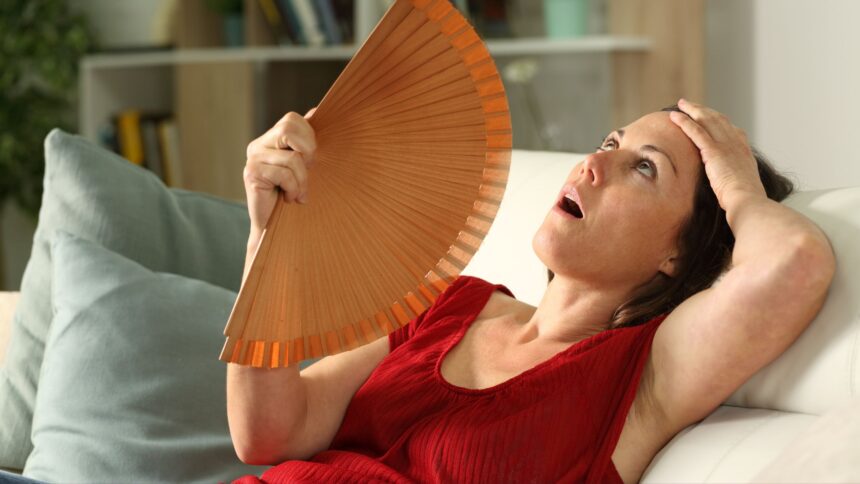Menopause is a natural transition that all women go through as they get older. For many, it can bring symptoms like hot flashes, trouble sleeping, mood changes, and other discomforts. As Mary entered her late 40s, she could feel her body changing. The fluctuations began—one day she felt fine and the next the hot flashes had her tossing and turning all night. The lack of sleep made it difficult for her to care for her family and maintain her career. She wanted relief but was nervous about taking traditional hormone therapy due to the potential health risks. This is when she began exploring natural alternatives for menopause support. Let’s take a look at some of the most popular natural options women turn to during this life stage.
What is the best natural hormone replacement for menopause?
Herbal Supplements
Black cohosh is one of the top herbal supplements recommended for balancing hormones during menopause. As Mary’s symptoms intensified, her doctor suggested giving it a try. “I was willing to try anything to get some relief,” she said. Black cohosh seemed to take the edge off during the day and allowed her to sleep more soundly at night. While the research is still emerging, for many women it provides natural symptom relief.
Soy isoflavones are another supplement derived from soybeans. Preliminary studies show they may alleviate hot flashes and night sweats by mimicking the effects of estrogen in the body. Jane added a soy supplement to her diet on the advice of a friend who swore by it. Within a few weeks, she noticed a big difference—fewer dreaded hot flashes! While soy is generally well tolerated, it interacts with some medications so it’s important to talk to your doctor first.
Promising research also exists for supplements like Dong Quai, red clover, and wild yam. Individually or combined in a high-quality menopause formula, many women find an herbal approach allows them to avoid harsh side effects while still experiencing relief. Trial and error helps determine the best natural fit for an individual’s hormone imbalance and symptoms.
Diet and Lifestyle Changes
Making adjustments to diet and daily habits can also support overall wellness during the menopause transition. Eating more phytoestrogens from whole foods like flaxseeds, berries, lentils, and cruciferous veggies may mimic estrogen’s effects in the body. Limiting alcohol, caffeine, and spicy foods, which can trigger flushes, provides additional relief.
Exercise is crucial for physical and mental health, yet another trigger is inactivity from fatigue. Lisa researched low-impact routines and now walks daily, and does yoga or water aerobics a few times a week. This has lifted her mood and energy levels tremendously. Getting quality sleep, managing stress through activities like journaling or meditation, and reconnecting socially also impact how women experience menopause symptoms. A holistic lifestyle approach, with or without supplements, leads to overall well-being.
Making the Best Choice
Every woman’s needs and symptoms are different. While traditional hormone therapy can control menopause issues extremely well for some, the health risks make it unsuitable for many others. Natural solutions allow women like Jane, Susan, and Lisa to feel like themselves again without harsh medications. Taking vitamins, changing diet and activities, or experimenting with herbal blends provides options to relieve discomfort.
With some trial and error, support from their doctors, and open communication with other women going through it too, they found natural approaches that worked best for them. In the end, finding relief from menopause in a way that feels right is what really matters. With patience and empowerment, every woman can navigate this transition confidently on her own unique path.
FAQs:
Why don’t the Japanese get menopause symptoms?
For many going through menopause, symptoms like hot flashes, mood changes and sleep troubles can make daily life a challenge. This individual remembered hearing how women in Japan seemed to experience menopause much more smoothly. Curious to understand why, they began researching the topic.
Studies show genetics alone don’t account for the difference. Diet and lifestyle play a key role. The traditional Japanese diet focuses on soy products, seaweed, certain vegetables, and fish. These contain phytoestrogens that mimic estrogen’s effects in the body. Compared to a typical Western diet higher in red meat and dairy, Japanese diets have more isoflavones from tofu, miso, and edamame. Research shows plant compounds can lower hot flashes by over 50% and aid bone and heart health too.
Regular physical activity is also part of Japanese culture through activities like hiking, biking, and housework. Staying active improves sleep and reduces stress. Having a strong community provides emotional support through conversations that normalize menopause versus causing shame. Realizing how their lifestyle impacted the easy transition, this individual began incorporating more soy and traditional dishes hoping to help others experience menopause more smoothly as well.
What is the strongest natural estrogen?
When certain remedies weren’t right due to health risks, exploring botanical estrogens began. One plant compound kept emerging in studies as showing promise—estriol. Found in small amounts in humans, it’s the weakest estrogen before menopause but may become most potent afterward.
Estriol levels don’t remain high after menopause, but research shows it mimics the body’s estrogen production to relieve many symptoms. As a milder estrogen, concerns are lower for risks like some experience with other therapies. Estriol cream applied externally meant avoiding potential digestive issues too.
After discussing with a medical practitioner, a low-dose cream began. Symptom relief followed substantially without side effects. While more investigation is still warranted, numerous experts now consider estriol the most potent, safest botanical form that avoids the risks of other therapies for suitable candidates. For some, it delivers needed solace naturally.
What is the Japanese diet for menopause?
This individual remembered leaning on traditional Japanese cuisine through life changes. As certain symptoms emerged, recalling elder recommendations focused attention on natto, seaweed, soy products, yuzu, and shiitake mushrooms prominent in the diet.
- Soy foods like tofu, edamame, and miso contain high amounts of isoflavones linked to easing menopause signs. Seaweed’s fucoxanthin assists in weight management and heart welfare during this stage. Shiitake mushrooms benefit bone and heart health via qualities similar to estrogen.
- Bright yuzu citrus offers antioxidants while supporting mood stability. Complex carbs from brown rice and grains balance blood sugar’s effect on flushes. Leafy greens, burdock root and lotus root also hold phytoestrogens.
- Fermented foods like pickled vegetables aid digestion during hormonal flux. Animal items are had in moderation, with more focus on fish than red meat. Daily activities incorporate mild exercises and relaxing baths.
Adopting this longevity-focused, anti-inflammatory dietary approach provided needed relief according to individual needs naturally during this transition.
Who should not take red clover?
When praising red clover’s help with flushes reached this person, excitement grew to try it. However, speaking with a medical expert revealed it carries risks for some. Women using medications metabolized through the liver like statins or blood thinners should avoid potential interactions.
Individuals with a history of breast or uterine cancers also require prudence with red clover due to its estrogenic impacts, like with other botanicals. Long-term safety remains unknown for these groups. It could interact with fertility drugs too.
In relation to breast cancer survivors, red clover posed too substantial a risk. While thrilled for the success of that individual, this person realized an alternate was wiser sans probable unfavorable effects. Discussing options thoroughly ensures selecting the most risk-free, helpful natural remedies suited to each individual’s well-being confidently navigating this transition.
What can I take instead of estrogen for menopause?
When certain modifications arouse worrying mammary changes, conventional estrogen therapies weren’t right. This launched an investigation into safer plant-based selections.
- High on the list were black cohosh supplements. Multiple investigations demonstrate relieving hot flashes, night sweats, and mood shifts equal to pharmaceuticals yet without cancer or breast risks. Chinese herb dong quai also alleviates vaginal dryness and steadies cycles during perimenopause, as do soy items like tofu, edamame, and soy milk containing phytoestrogens.
- Ginseng, Vitamin E, and wild yam cream used externally benefitted many as well. Turmeric’s curcumin blocks inflammation which may lessen flushes. B vitamins like B1, B6, and folate sustain neurotransmitters amid stressful mood changes.
- Homeopathy choices like sepia and Calcarea carbonica target specified symptom patterns. Adjusting lifestyle for activity, sleep, and pressure management brought extra support. With these natural substitutes supplying aid devoid of danger, confidently continuing through menopause felt achievable.
How can I increase my estrogen naturally in menopause?
When hormonal ebb struck early at 43, such lowness imposed hardship. Motivated to elevate levels harmlessly, dietary and routine pivots commenced. Soy products topped the new regimen. Tofu, soybeans, and tempeh contain phytoestrogens similar to the body’s own estrogen structure. Studies show raising estrogen by 10-15%.
Whole foods contain estrogenic properties like flaxseed, sesame, lentils, chickpeas, citrus, and berries. Exercises such as walking, yoga, and weights improved cardiovascular health and ignited natural formation too. Getting adequate rest and controlling pressure through breathwork aided relaxation important amid fluctuations.
Herbal allies like black cohosh, dong quai, and licorice root helped stabilize hormones as well. Supplementing with DIM from brassicas and calcium D-glucarate assisted the liver’s removal of excess estrogen. Drinking plant or green teas offered phytoestrogens and antioxidants. Paying attention to monthly cycles via an application granted knowledge about undulations. With patience and consistency, embracing these wholesome, lifestyle adjustments noticed rewards.
How can I survive menopause without HRT?
When raging flushes and sleepless nights arose, nutritional aids alone weren’t sufficient. Positive lifestyle pivots grew vital for well-being without HRT.
Swapping coffee for green tea decreased caffeine-linked flares. Steering clear of spicy food-provoking flushes too. Gentle everyday exercise like yoga soothed pressure then relaxing with aromatherapy diminished tension. Coping strategies reconditioned the mind-body reaction amid anxiety and irritation.
Meals contained bone-constructing and mood-steading nutrients. Fermented choices are digested easier throughout digestive changes. Flaxseeds, berries, and soy are sustained with phytoestrogens. Expressive journaling released considerations causing unrest versus repetitive thinking.
Social interaction boosts spiritually and emotionally. Uncluttering simplified stress triggers as vitality fluctuated. Stipulations during overload halted burnout. Restorative self-care through Epsom salt baths, meditation apps, and limiting screens regained energy.
Implementing holistic techniques empowers navigating difficulties with health, positivity, and lacking dependence solely on medications. Concentrating on general welfare equipped various resources for prospering.
Is there a herbal equivalent to HRT?
For some, black cohosh has authenticated itself as an herbal match for pharmaceutical therapy. When this approach interested one strongly, black cohosh surfaced upon exploration.
Numerous investigations attest it decreases the most common signs of menopause including hot flashes, night sweats, and mood variations similar to prescription HRT. Its estrogen-replicating activity relieves oscillation. No amplified cancer risk of the breast or womb exists either.
Certain herbalists deem partnership formulas more active. One blend combines therapeutic doses of black cohosh along with other botanicals. Studies show it cuts hot flashes by 80% within 4 weeks, analogous to prescription drug outcomes. While long-term information over decades isn’t obtainable like chemical treatment, the all-natural alternative avoids breast cancer risks still concerning some practitioners. For individuals desiring plant-based aid, black cohosh and combination herbal formulas have confirmed enormously compelling options.
What is the best supplement to replace estrogen?
For one, easing menopause without standardized chemicals felt imperative. Many supplements aided insomnia, sweats, and shifts unsuccessfully until acupuncture unveiled a meaningful signpost.
Their specialist advised complementing with 7-keto DHEA, a biosimilar to estrogen naturally produced by the body. As an intermediary in estrogen formation, 7-keto advocates proper levels regulating symptoms. Multiple peer-reviewed trials confirm above a 50% hot flash decrease with no increased dangers.
Noticing a difference within a month as the 25mg capsule dissolved under the tongue daily, no more soaked sleepwear arose! Their energy lifted and slumber came easier. The additive’s advantages endured all day without fluctuations from oral ingestion. And unlike synthetic estrogens in HRT, 7-keto intended no issues for breast or uterine wellbeing.
For numerous during perimenopause and post-menopause, 7-keto DHEA presents the finest natural choice to restore youthful hormonal equilibrium safely and delicately. With this individual now assured and thriving symptom-free, it proved itself a thoughtful different than estrogen replacement therapy for their requirements.
Every person’s needs and reactions are distinctive. While standard hormone treatment can control menopause issues exceptionally well for some, potential risks cause worries for others seeking more natural paths. Exploring tools like dietary and lifestyle modifications, herbal medicines, supplements, and homeopathic or chiropractic support allows menopausal individuals diverse avenues for discovering wellness that harmonizes body, mind, and soul during this life transition. With communication between open-minded medical practitioners and their patients, the most empowering options surface for each to navigate confidently at their own pace.




